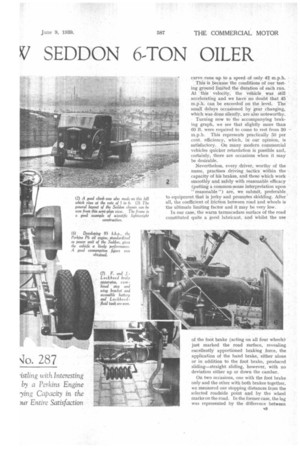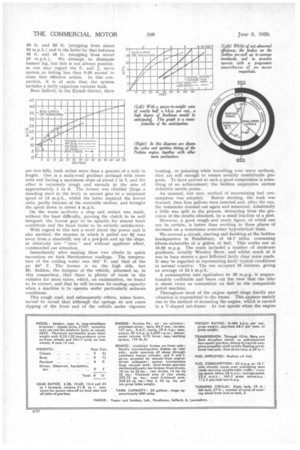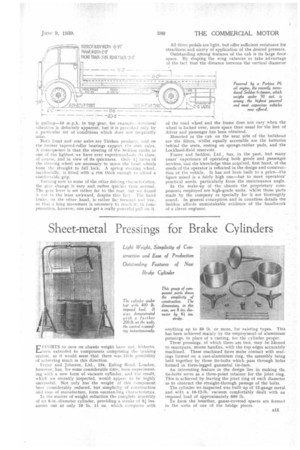FIRST ROAD TEST OF IN Ki SEDDON 6-TON OILER
Page 42

Page 43

Page 44

Page 45

If you've noticed an error in this article please click here to report it so we can fix it.
WHILST the introduction by Foster and Seddon, Ltd., of a new commercial vehicle, named the Seddon, was announced in this paper last October, and the machine made its first public appearance in Glasgow during the Scottish Show in the following month, production of the chassis did not commence until the end• of March. Already, however, a number are in use, 22 having actually been sold.
In two cases, repeat orders have been fulfilled, which may be regarded as proof that the operators concerned are confident, as a result presumably of their experiences up to date, that the machines will continue to meet their requirements efficiently. The vehicle which forms the subject of this report has been built for Messrs. Fred Edlin, Blaby, and will be the fourth Seddon to go into the service of this operator. When we took it over, the mileage it had covered was only 20, but nothing occurred during the day to suggest that it required running in. Our first impressions, formed from the passenger's seat, were of the liveliness of the vehicle. Frequently, we have found that the result of loading 6 tons on to lorries weighing unladen no more than 50 cwt. is to render them sluggish, so that constant changes into third gear are necessary on normal roads.
With a power-to-weight ratio of nearly 0.5 b.h.p. per cwt., however, the Seddon displayed• a flexibility and acceleration that one commonly associates with vehicles of lower pay-load rating.
Our acceleration tests, the results of which form the basis of an accompanying graph, corroborated our first impressions, and it will be seen that 30 m.p.h. can be attained in about 35 seconds, which compares favourably with similar petrol machines. It will be noted by reference to this graph that the oh curve runs up to a .speed. of only 42 m.p.h.
This is because the conditions of our testing ground limited the duration of eaCh run. At this ' velocity, the vehicle was still accelerating and we have no doubt that 45 m.p.h. can be exceeded on the level. The small delays occasioned by gear changing, which VMS done silently, are also noteworthy_ Turning now to the accompanying braking graph, we see that slightly more than 60 ft. were required to come to rest from 30 m.p.h. This represents practically 50 per cent, efficiency, which, in our opinion, is satisfactory. On many modern commercial vehicles quicker retardation is possible and, certainly, there are occasions when it may be desirable.
Nevertheless, every driver, worthy of the name, practises driving tactics within the capacity of his brakes, and those which work smoothly and safely with reasonable efficacy (putting a common-sense interpretation upon "reasonable ") are, we submit, preferable to equipment that is jerky and promotes skidding. Alter all, the coefficient of friction between road and wheels is the ultimate limiting factor and it may be very low.
In our case, the warm tarmacadarn surface of the road constituted quite a good lubricant, and whilst the use of the foot brake (acting on all four wheels) just marked the road surface, revealing excellently apportioned braking force, the application of the hand brake, either alone or in addition to the foot brake, produced sliding—straight sliding, however, with no deviation either up or down the camber.
On two occasions, one with the foot brake only and the other with both brakes together, we measured our stopping distances from the selected roadside point and by the wheel marks on the road. In the former case, the lag was represented by the difference between 59 ft. and 69 ft. (stopping from about 33 m.p.h.) and in the latter by that between 36 ft. and 48 ft. (stopping from about 23 m.p.h.). We attempt to eliminate human lag, but this is not always possible, so one may regard the F. and J. servo system as taking less than 0.05 second to come into effective action. In this connection, it is of note that the system includes a fairly capacious vacuum tank.
Near Salford, in the Kirsall district, there
are two hills, both rather more than a quarter of a mile in length. One is a main-road gradient surfaced with stone setts and having a maximum slope of about 1 in 7, and the other is extremely rough and ascends at the rate of approximately 1 in 6. The former was climbed (from a standing start at the foot) in second gear 'at a minimum speed of 13 m.p.h., whilst the latter required the lowest ratio, partly because of the execrable surface, and brought the speed down to about 4 m.p.h.
On the worse acclivity a stop and restart was made, without the least difficulty, proving the clutch to be well designed, the lowest gear to be suitable for almost freak conditions and the hand brake to be entirely satisfactory.
With regard to this test a word about the power unit is also merited; the manner in which it pulled our 81 tons away from a standstill, out of a pot-bole and up the slope, at relatively low " revs." and without apparent effort, commanded our attention.
Immediately after -making these two climbs in quick succession we took thermometer readings. The temperature of the cooling water was 1940 F. and that of the air 640 F. The former is on the high side, but Mr. Seddon, the designer of the vehicle, informed us, in this connection, that there is plenty of room in the radiator for more tubes, which, on examination, we found to be correct, and that he will increase its cooling capacity when a machine is to operate under particularly arduous conditions.
This rough road, and subsequently others, taken faster, served to reveal that although the springs do not cause dipping of the front end of the vehicle under vigorous braking, or prancing while travelling over wavy surfaces, they are soft enough to ensure notably comfortable progress. To have arrived at such a good compromise is something of an achievement; the Seddon suspension system definitely merits praise.
An unusual, but sure, method of ascertaining fuel con sumption was adopted. Before starting, the tank was drained, then four gallons were inserted and, after the run, the remainder drained out again and measured, Admittedly a little was spilt in the process, detracting from the precision of the results obtained, by a small fraction of a pint.
However, a good rough and ready figure, of which one can be certain, is better than working to three places of decimals on a sometimes somewhat hypothetical basis.
We covered a circuit, starting and finishing at the Seddon headquarters in Peridlebury, of 18.7 miles, consuming fifteen-sixteenths of a gallon of fuel. This works out at 19.95 m.p.g. The route included a number of moderate gradients, notably Worsley Brow, and whilst much of it was in busy streets a part followed fairly clear main roads. It may be regarded as representing fairly typical conditions in normal country. The run occupied 50 minutes, giving an average of 22.4 m.p.h.
A consumption rate equivalent to 20 m.p.g. is unquestionably creditable and bears out the view that the oiler is about twice as economical on fuel as the comparable petrol machine. Throughout 'most of the engine speed range hardly any vibration is transmitted to the frame. This appears mainly due to the method of mounting the engine, which is carried in a V-shaped sub-frame. At low speeds when the engine is pulling-10 m.p.h. in top gear; for example-• torsional vibration is definitely apparent, but it is provoked only by a particular set of conditions which does not frequently arise.
Both front and rear axles are Timken products, and on the former tapered-roller bearings support the stub axles: A consequence is that the steering of the Seddon ranks as one of the lightest we have ever experienced—ia its class, of course, and in view of its quickness. Only LI turns of the steering wheel are necessary to move the front wheels. from the straight to full lock. A spring steering wheel, incidentally, is fitted with a rim thick enough to afford a corn to viable grip.
Turning now to some of the other driving characteristics. the gear change is easy and rather quicker than normal. The gear lever is set rather far to the rear, but we found it not in the least awkward, despite this fact. The hand brake, on the other hand, is rather far forward and low, so that a long movement is necessary to reach it: in compensation, however, one can get a really powerful nal; on it. All three pedals are light, but offer sufficient resistance for steadiness and nicety of application of the desired pressure.
Outstanding among features of the cab is its large floor space. By shaping the wing valances to take advantage of the fart that the distance between the vertical diameter of the road wheel and the frame does not vary when the wheel is locked over, more space than usual for the feet of driver arid passenger has been obtained. Mounted in the cab on the near side of the bulkhead are the filters, whilst equally accessible are the batteries behind the seats, resting on sponge-rubber pads, and the Lockheed-fluid reservoir.
Foster and Seddon, Ltd., has, in the past, had many years' experience of operating both goods and passenger services, and the knowledge thus acquired, first hand, of the needs of the operator is reflected in the design and construction of the vehicle. It has not been built to a price—the figure asked is a fairly high one—but to meet operators' practical needs, particularly from the maintenance angle. In the make-up of the chassis the proprietary components employed are high-grade units, whilst those parts made by the company or specially for it are thoroughly sound. In general conception and in countless details the Seddon affords unmistakable evidence of the handiwork of a clever engineer.




















































































